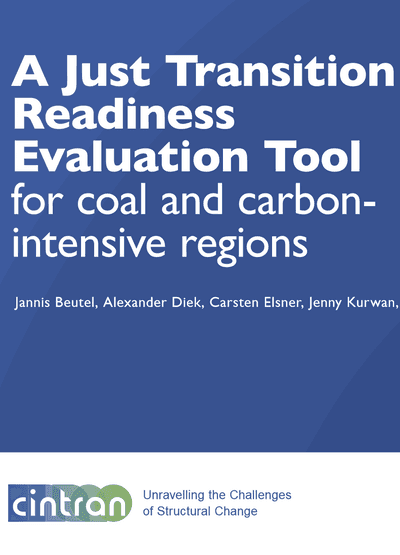While the decarbonisation of the energy sector is slowly gaining pace, just transition implementation in coal and carbon intensive regions is often a black box, lacking a basic consensus about its goal and focus. CINTRAN’s new Just Transition Readiness Evaluation Tool aims to open that black box by identifying policy areas & approaches that are relevant for a just transition on the local level as a first step to truly advance on implementation.
CINTRAN’s Just Transition Readiness Evaluation Tool
To date, policies to realise a so-called ‘just transition’ mostly focus on technological changes, fostering economic diversification and compensation schemes for workers. We argue that this will not be enough to realise a just transition in a way that is fair for all – it would over- look already existing and anticipated future injustices that are interconnected to the impacts of the fossil fuel industry itself, the transition and the societal system that is in place today.
The ‘Just Transition Readiness Evaluation Tool’ (JT:READY) aims to enable policy-makers and practitioners in coal and carbon-intensive regions in Europe to understand and use a whole-system approach to just transition and learn how it can be subsequently translated into local action.
The tool is designed following a step-by-step logic, starting at the very beginning of why there needs to be a transition in the first place and what exactly ‘just’ means, and then subsequently arguing how the principles of just transition can guide the identification of goals, levers and policy fields. At the core, the tool provides a comprehensive
overview about the themes and topics that play a role for just transition policy development and suggestions and examples for policy responses.
Based on a whole-systems understanding of just transition, it takes into account distributional, procedural and recognitional justice considerations combined with a clear focus on striving for ecological prosperity and showcasing how sub-national policies can support that process. In that sense, the tool enables practitioners in the regions to identify levers and triggers for starting deep structural change processes that can kick off the much-needed transformational dynamic to realise a just and in-time transition to climate-neutrality.

A visualisation of the JT:READY framework. The tool subsequently presents a way of how to start from principles to identify policy areas and measures for just transition implementation.
The JT:READY Just Transition Readiness Evaluation Tool is a framework that provides an overview about the main thematic areas (we call them ‘transition levers’) that are relevant to realise a whole-systems policy approach to just transition, followed by sub-questions for each policy area. All policy areas together condense what can be considered as needed to eventually reach the main just transition goals.
At the core, the tool provides guidance for each policy area on:
- WHY there should be policies on a certain topic, describing the societal and/ or environmental challenges and how it is connected to the justice or planetary boundaries concept;
- WHAT can be done more broadly to tackle the challenges mentioned, drawing on latest knowledge and policy recommendations to reach a just transition; and
- HOW that can be subsequently addressed by the local or regional governance levels, providing examples of policy instruments and policy strategies that can be used, as well as
- EXAMPLES of real-world applications and FURTHER READING materials that can help to get a better idea of what measures are possible.

At the core, the Just Transition Readiness Evaluation Tool (JT:READY) provides an overview about 34 policy areas that are relevant for realising a just transition from a whole-systems perspective. For each, it explains why it is needed, what is needed and how the local level can address it, including policy examples and links to further guidance.
By using the JT:READY tool, local stakeholders can analyse the following:
- Completeness of just transition planning: Which aspects of a (whole-systems) just transition are currently already addressed, and which areas were overlooked?
- Mandate to make changes: In which areas does the region or municipality have the authority to develop own policies and in which areas do they need to coordinate (more) with higher political levels?
- Instruments for steering the transition: What could be levers to steer development towards just transition in the areas that have not been addressed yet?
- Priorities for getting started: What are the priorities for developing local policy instruments, given that most likely not all challenges can be tackled at the same time?
Finding answers to those questions will be especially important to develop regional transition strategies, e.g., by clarifying what just transition understanding the region has, how civil society integration can be further supported (if underdeveloped in current transition readiness), or strengthening social aspects in existing legislation based on transition justice considerations.
Realising a just transition that is both fully in line with planetary boundaries and perceived as just is by far not easy, but necessary. With JT:READY, stakeholders now have a powerful tool at hand to support them in this process.
Related Publications


Funding
The CINTRAN project has received funding from the European Union’s Horizon 2020 research and innovation programme under grant agreement No. 884539. The sole responsibility for the content of this website lies with the authors and does not necessarily reflect the opinion of CINEA or other EU agencies or bodies.


